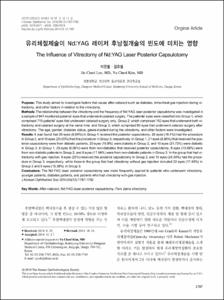유리체절제술이 Nd:YAG 레이저 후낭절개술의 빈도에 미치는 영향
- Keimyung Author(s)
- Kim, Yu Cheol
- Department
- Dept. of Ophthalmology (안과학)
- Journal Title
- 대한안과학회지
- Issued Date
- 2014
- Volume
- 55
- Issue
- 12
- Abstract
- Purpose: This study aimed to investigate factors that cause after-cataract such as diabetes, intravitreal gas injection during vitrectomy, and other factors in relation to the vitrectomy.
Methods: The relationship between the vitrectomy and the frequency of Nd:YAG laser posterior capsulotomy was investigated in a sample of 947 monitored patients’ eyes that underwent cataract surgery. The patients’ eyes were classified into Group 1, which comprised 715 patients’ eyes that underwent cataract surgery only, Group 2, which comprised 152 eyes that underwent both vitrectomy and cataract surgery at the same time, and Group 3, which comprised 80 eyes that underwent cataract surgery after vitrectomy. The age, gender, diabetes status, gases injected during the vitrectomy, and other factors were investigated.
Results: It was found that 50 eyes (6.99%) in Group 1 received the posterior capsulotomy, 28 eyes (18.4%) had the procedure in Group 2, and 16 eyes (20.00%) had the procedure in Group 3, respectively. In Group 1, 21 eyes (8.86%) that received the posterior capsulotomy were from diabetic patients, 20 eyes (19.8%) were diabetic in Group 2, and 10 eyes (21.73%) were diabetic in Group 3. In Group 1, 29 eyes (6.06%) were from non-diabetics that received posterior capsulotomy, 8 eyes (15.68%) were from non-diabetic patients in Group 2, and 6 eyes (17.64%) were from non-diabetic patients in Group 3. In the group that had vitrectomy with gas injection, 6 eyes (25%) received the posterior capsulotomy in Group 2, and 10 eyes (24.39%) had the procedure in Group 3, respectively, while those in the group that had vitrectomy without gas injection included 22 eyes (17.46%) in Group 2 and 6 eyes (15.38%) in Group 3.
Conclusions: The Nd:YAG laser posterior capsulotomy was more frequently applied to patients who underwent vitrectomy, younger patients, diabetes patients, and patients who had vitrectomy with gas injection.
목적: 유리체절제술의 유무와 관련하여 당뇨, 유리체절제술 시 가스주입술의 유무 등 후발백내장 발생에 영향을 주는 인자들에 대해 알아보고자 하였다.
대상과 방법: 2007년 1월부터 2010년 12월까지 백내장수술을 받고 2년 이상 추적 관찰한 환자 947안을 대상으로 유리체절제술과 Nd:YAG 레이저 후낭절개술의 빈도와의 관계를 살펴보았다. 백내장수술만을 받은 환자(1군) 715안, 유리체절제술과 백내장수술을 동시에 시행 받은 환자(2군) 152안, 유리체절제술 후 백내장수술을 받은 환자(3군) 80안으로 군을 나누고 연령, 성별, 당뇨의 유무, 유리체절제술 시 가스주입술의 유무 등을 조사하였다.
결과: 후낭절개술을 시행한 경우는 1군 50안(6.99%), 2군 28안(18.40%), 3군 16안(20.00%)이었다. 당뇨환자 중 후낭절개술을 시행한 환자는 1군 21안(8.86%), 2군 20안(19.80%), 3군 10안(21.73%)이었으며, 비당뇨환자 중 후낭절개술을 시행한 환자는 1군 29안(6.06%), 2군 8안(15.68%), 3군 6안(17.64%)이었다. 유리체절제술 시 가스주입술을 시행한 군에서 후낭절개술을 시행한 환자는 2군 6안(25.00%), 3군 10안(24.39%)이었으며, 유리체절제술 시 가스주입술을 시행하지 않은 군에서 후낭절개술을 시행한 환자는 2군 22안 (17.46%), 3군 6안(15.38%)이었다.
결론: 유리체절제술을 받은 환자, 젊은 환자, 당뇨환자, 유리체절제술 시 가스주입술을 시행한 경우에 Nd:YAG 레이저 후낭절개술의 빈도가 더 높다.
- Alternative Title
- The Influence of Vitrectomy of Nd:YAG Laser Posterior Capsulotomy
- Keimyung Author(s)(Kor)
- 김유철
- Publisher
- School of Medicine
- Citation
- 이진철 and 김유철. (2014). 유리체절제술이 Nd:YAG 레이저 후낭절개술의 빈도에 미치는 영향. 대한안과학회지, 55(12), 1787–1792. doi: 10.3341/jkos.2014.55.12.1787
- Type
- Article
- ISSN
- 0378-6471
- Appears in Collections:
- 1. School of Medicine (의과대학) > Dept. of Ophthalmology (안과학)
- 파일 목록
-
-
Download
 oak-bbb-02668.pdf
기타 데이터 / 466.6 kB / Adobe PDF
oak-bbb-02668.pdf
기타 데이터 / 466.6 kB / Adobe PDF
-
Items in Repository are protected by copyright, with all rights reserved, unless otherwise indicated.